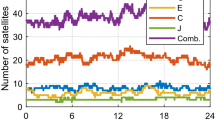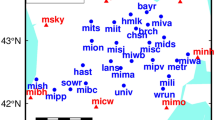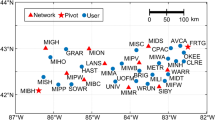Abstract
Successful implementation of integer ambiguity resolution enabled precise point positioning (aka PPP-RTK) algorithms is inextricably linked to the ability of a user to perform near real-time positioning by quickly and reliably resolving the integer carrier-phase ambiguities. In the PPP-RTK technique, a major barrier to successful ambiguity resolution is the unmodelled impact of the ionosphere. We present a 4D ionospheric tomographic model that computes in real time the ionospheric electron density as a linear combination of basis functions, namely B-splines. The results show that when the ionospheric estimates are provided as atmospheric corrections for a PPP-RTK end-user, the time to fix its horizontal position below 10 cm is around 20 epochs (the sample rate is 30 s) at the \(90\%\) of the cumulative distribution function (CDF), as opposed to the time it takes when no external corrections are provided, which is around 80 epochs at \(90\%\) of the CDF.




Similar content being viewed by others
Notes
\(1~\hbox {TECU} = 10^{16}\, e^-/m^2\); \(e^-= 1\) electron.
By real time we mean updating the estimates as the observations and corrections are provided, typically less than 1 min.
References
Banville S (2014) Improved convergence for GNSS precise point positioning. Ph.D. dissertation, Department of Geodesy and Geomatics Engineering, Technical Report No. 294, University of New Brunswick, Fredericton, New Brunswick, Canada
Chambodut A, Panet I, Mandea M, Diament M, Holschneider M, Jamet O (2005) Wavelet frames: an alternative to spherical harmonic representation of potential fields. Geophys J Int 163(3):875–899. https://doi.org/10.1111/j.1365-246X.2005.02754.x
Feltens J, Angling M, Jackson-Booth N, Jakowski N, Hoque M, Hernandez-Pajares M, Aragon-Angel A, Orus R, Zandbergen R (2011) Comparative testing of four ionospheric models driven with GPS measurements. Radio Sci 46(6):1–11
Flanigan FJ (1983) Complex variables. Dover books on mathematics. Dover Publications, Mineola
Hadas T, Krypiak-Gregorczyk A, Hernández-Pajares M, Kaplon J, Paziewski J, Wielgosz P, Garcia-Rigo A, Kazmierski K, Sosnica K, Kwasniak D, Sierny J, Bosy J, Pucilowski M, Szyszko R, Portasiak K, Olivares-Pulido G, Gulyaeva T, Orus-Perez R (2017) Impact and implementation of higher-order ionospheric effects on precise GNSS applications. J Geophys Res Solid Earth. https://doi.org/10.1002/2017JB014750
Haines GV (1988) Computer programs for spherical cap harmonic analysis of potential and general fields. Comput Geosci 14(4):413–447
Hernandez-Pajares M, Juan JM, Sanz J (1999) New approaches in global ionospheric determination using ground GPS data. J Atmos Solar Terr Phys 61:1237–1247
Hernandez-Pajares M, Juan JM, Sanz J, Aragon-Angel A, Garcia-Rigo A, Salazar D, Escudero M (2011) The ionosphere: effects, GPS modeling and the benefits for space geodetic techniques. J Geod. https://doi.org/10.1007/s00190-011-0508-5
Hernandez-Pajares M, Juan JM, Sanz J, Orús R (2014) Second-order ionospheric term in GPS: implementation and impact on geodetic estimates. J Geophys Res Solid Earth 112:B08417. https://doi.org/10.1029/2006JB00470
Hernandez-Pajares M, Roma-Dollase D, Krankowski A, Garcia-Rigo A, Orus-Perez R (2017) Methodology and consistency of slant and vertical assessments for ionospheric electron content models. J Geod. https://doi.org/10.1007/s00190-017-1032-z
Jakowski N (2008) Ionospheric impact on GNSS signals. Fisica de la Tierra 20:1125
Khodabandeh A, Teunissen PJG (2015) An analytical study of PPP-RTK corrections: precision, correlation and user-impact. J Geod 89(11):1109–1132
Ma G, Maruyama T (2003) Derivation of TEC and estimation of instrumental biases from GEONET in Japan. Annal Geophys 21:2083–2093
Mautz R, Ping J, Heki K, Schaffrin B, Shum C, Potts L (2005) Efficient spatial and temporal representation of global ionosphere maps over Japan using B-spline wavelets. J Geod 78:660–667. https://doi.org/10.1007/s00190-004-0432-z
Nie W, Xu T, Rovira-Garcia A, Juan Zornoza JM, Sans Subiran J, González-Casado G, Chen W, Xu G (2018) Revisit the calibration errors on experimental slant total electron content (TEC) determined with GPS. GPS Solut 22:85. https://doi.org/10.1007/s10291-018-0753-7
Odijk D (2002) Fast precise GPS positioning in the presence of ionospheric delays. Publications on geodesy, vol 52. The Netherlands Geodetic Commission, Delft. ISBN-13: 978 90 6132 278 8
Odijk D, Khodabandeh A, Nadarajah N, Choudhury M, Zhang B, Li W, Teunissen PJG (2016) PPP-RTK by means of S-system theory: Australian network and user demonstration. J Spat Sci 62:3–27
Petrie EJ, King MA, Moore P, Lavallée DA (2010) A first look at the effects of ionospheric signal bending on a globally processed GPS network. J Geod 84(8):491–499. https://doi.org/10.1007/s00190-010-0386-2
Petrie EJ, Hernandez-Pajares M, Spalla P, Moore P, King MA (2011) A review of higher order ionospheric refraction effects on dual frequency GPS. Surv Geophys 32(3):197–253. https://doi.org/10.1007/s10712-010-9105-z
Schaer S (1999) Mapping and predicting the Earth’s ionosphere using the global positioning system. Ph.D. dissertation, Astron Institute, University of Bern, Berne
Schmidt M (2007) Wavelet modelling in support of IRI. Adv Space Res 39:932940. https://doi.org/10.1016/j.asr.2006.09.030
Schmidt M, Bilitza D, Shum C, Zeilhofer C (2008) Regional 4-D modeling of the ionospheric electron density. Adv Space Res 42:782790. https://doi.org/10.1016/j.asr.2007.02.050
Schmidt M, Dettmering D, Mößmer M, Wang Y, Zhang J (2011) Comparison of spherical harmonic and B spline models for the vertical total electron content. Radio Sci. 46:RS0D11. https://doi.org/10.1029/2010RS004609
Stengel RF (1994) Optimal control and estimation. Dover Publications Inc., New York
Stollnitz EJ, DeRose TD, Salesin DH (1995) Wavelets for computer graphics: a primer 2. IEEE Comput Graph Appl 15(4):75–85
Teunissen PJG, Khodabandeh A (2015) Review and principles of PPP-RTK methods. J Geod 89(3):217240
Teunissen PJG, Kleusberg A (1998) GPS for geodesy. Springer, Berlin
Teunissen PJG, Montenbruck O (2017) Handbook of global navigation satellite systems. Springer, Berlin. ISBN 978-3-319-42926-7. https://doi.org/10.1007/978-3-319-42928-1
Themens DR, Jayachandran PT, Langley RB, MacDougall JW, Nicolls MJ (2012) Determining receiver biases in GPS-derived total electron content in the auroral oval and polar cap region using ionosonde measurements. GPS Solut 17:357
Zeilhofer C (2008) Multi-dimensional B-spline modeling of spatio-temporal iono-spheric signals, Reihe A123, Deutsche Geodtische Kommission bei der Bayerischen Akademie der Wissenschaften
Zhang B (2016) Three methods to retrieve slant total electron content measurements from ground-based GPS receivers and performance assessment. Radio Sci 51:972988. https://doi.org/10.1002/2015RS005916
Zumberge JF, Heflin MB, Jefferson DC, Watkins MM, Webb FH (1997) Precise point positioning for the efficient and robust analysis of GPS data from large networks. J Geophys Res 102:50055017
Acknowledgements
This work has been supported by the Cooperative Research Centre for Spatial Information, whose activities are funded by the Business Cooperative Research Centres Programme.
Author information
Authors and Affiliations
Corresponding author
Appendix
Appendix
Equation (9) can be rearranged into one single equation as follows:
The optimal solution (in a LLS sense) for Eq. (16) corresponds to the argument \(\mathbf{x}_k\) that minimizes the error, i.e.
whose solution is as follows
where \(\mathbf{z}_k\,\equiv [\mathbf{y}_k^\mathrm{T}, \,\, \mathbf{f}^\mathrm{T}\left( {\hat{\mathbf{x}}}_{k-1}\right) ]^\mathrm{T}\); \({{\varvec{{\Omega }}}}_k\) is the matrix that maps the state-space estimates onto the observations and onto the a priori state-space estimates,
which is always full rank due to the presence of the identity matrix.
The covariance of the state-space estimates is
where \(\mathbf{E}_k\) is the covariance of the measurements \(\mathbf{y}_k\), and \(\mathbf{Q}_{\mathbf{f}\left( {\hat{\mathbf{x}}}_{k-1}\right) }\) is the covariance of the stochastic dynamic model \(\mathbf{f}\left( {\hat{\mathbf{x}}}_{k-1}\right) \).
The covariance of the estimates \({\hat{\mathbf{x}}}_k\) is as follows:
which, after developing the right-hand side, yields
The matrix inversion lemma, e.g. Stengel (1994), states that
thence, after replacing Eq. (23) in Eq. (22), it leads to the following expression
where \(\mathbf{K}_k\), the gain matrix, is defined as follows
Finally, by using Eq. (24) in Eq. (18), and noting that
the following expression is obtained:
Rights and permissions
About this article
Cite this article
Olivares-Pulido, G., Terkildsen, M., Arsov, K. et al. A 4D tomographic ionospheric model to support PPP-RTK. J Geod 93, 1673–1683 (2019). https://doi.org/10.1007/s00190-019-01276-4
Received:
Accepted:
Published:
Issue Date:
DOI: https://doi.org/10.1007/s00190-019-01276-4




